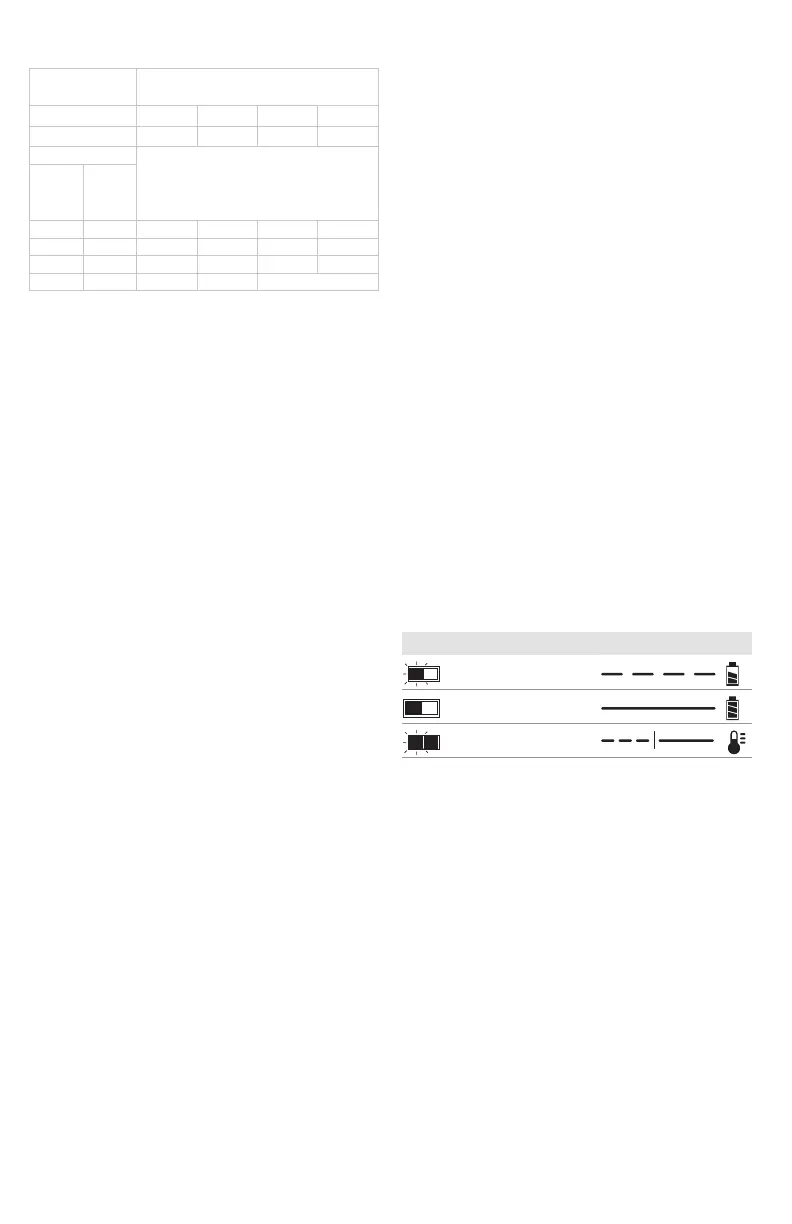ENGLISH
6
packs. Other types of batteries may overheat and burst
resulting in personal injury and propertydamage.
CAUTION: Under certain conditions,
with the charger plugged into the power supply, the
charger can be shorted by foreign material. Foreign
materials of a conductive nature, such as, but not
limited to, grinding dust, metal chips, steel wool,
aluminum foil or any buildup of metallic particles
should be kept away from the charger cavities. Always
unplug the charger from the power supply when there
is no battery pack in the cavity. Unplug the charger
before attempting toclean.
Charging a Battery
NOTE: To ensure maximum performance and life of lithium-
ion battery packs, charge the battery pack fully before
firstuse.
1. Plug the charger into an appropriate outlet before
inserting batterypack.
2. Connect the charger and battery pack, making sure
the battery is fully seated. The (charging) light will blink
continuously indicating that the charging process
hasstarted.
3. The completion of charge will be indicated by the light
remaining ON continuously. The battery pack is fully
charged and may be removed and used at this time or
left in the charger.
NOTE: To remove the battery pack, some chargers require
the battery pack release button to bepressed.
Indicators
Charging
Fully Charged
Hot/Cold Pack Delay*
* DCB107, DCB112, DCB113, DCB115, DCB118,
DCB132: The red light will continue to blink, but a yellow
indicator light will be illuminated during this operation.
Once the battery pack has reached an appropriate
temperature, the yellow light will turn off and the charger
will resume the charging procedure.
A charger will not charge a faulty battery pack. The charger
refusing to light could indicate a problem with the charger
or a faulty battery pack.
NOTE: If the charger refuses to light, take the charger and
battery pack to be tested at an authorized servicecenter.
Leaving the Battery Pack In the Charger
The charger and battery pack can be left connected with
the charge indicator showing pack charged.
Hot/Cold Pack Delay
When the charger detects a battery pack that is too hot
or too cold, it automatically starts a Hot/Cold Pack Delay,
suspending charging until the battery pack has reached an
appropriate temperature. The charger then automatically
Minimum Gauge for Cord Sets
Volts
Total Length of Cord in Feet
(meters)
120V 25 (7.6) 50 (15.2) 100 (30.5) 150 (45.7)
240V 50 (15.2) 100 (30.5) 200 (61.0) 300 (91.4)
Ampere Rating
American Wire Gauge
More
Than
Not
More
Than
0 6 18 16 16 14
6 10 18 16 14 12
10 12 16 16 14 12
12 16 14 12 Not Recommended
WARNING: If the plug or power cord is
damaged, it must be replaced by the manufacturer or
its representative or by an equally qualified person to
avoiddanger.
• Do not place any object on top of the charger or
place the charger on a soft surface that might block
the ventilation slots and result in excessive internal
heat. Place the charger in a position away from any heat
source. The charger is ventilated through slots in the top
and the bottom of thehousing.
• Do not operate the charger with a damaged cord
orplug–have them replaced immediately.
• Do not operate the charger if it has received a sharp
blow, been dropped or otherwise damaged in any
way. Take it to an authorized servicecenter.
• Do not disassemble the charger; take it to an
authorized service center when service or repair
is required. Incorrect reassembly may result in a risk of
electric shock, electrocution orfire.
• Disconnect the charger from the outlet before
attempting any cleaning. This will reduce the risk of
electric shock. Removing the battery pack will not reduce
thisrisk.
• NEVER attempt to connect 2 chargerstogether.
• The charger is designed to operate on standard
120V household electrical power. Do not attempt to
use it on any other voltage. This does not apply to the
vehicularcharger.
WARNING: Shock hazard. Do not allow
any liquid to get inside the charger. Electric shock
mayresult.
WARNING: Burn hazard. Do not
submerge the battery pack in any liquid or allow any
liquid to enter the battery pack. Never attempt to open
the battery pack for any reason. If the plastic housing
of the battery pack breaks or cracks, return to a service
center for recycling.
CAUTION: Burn hazard. To reduce the risk
of injury, charge only DeWALT rechargeable battery

